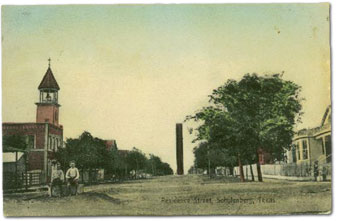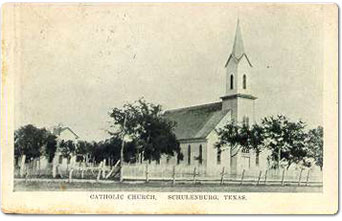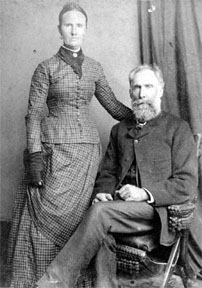No city in Texas has a greater reputation for the congeniality of its people than Schulenburg. The free and easy and yet refined manners of its inhabitants never fail to make the stranger feel at home. The splendor and the tasty arrangements of its festivities have made for Schulenburg the name of the festive city of South Texas.
Schulenburg is situated in the southern part of Fayette County on the Southern Pacific Railroad. it is at a distance of eighteen miles from the county seat. It lies in the rich black land Navidad prairie, one of the richest agricultural sections in the state. The elegant farm residences, the beautiful gardens in front of them, the rolling prairie laid out into fertile corn and cotton fields, speak of the industry and energy of its people and leave on the traveler a pleasing impression. The section is traversed by the Navidad and its tributary the Mixen Creek.
One mile southeast of Schulenburg lie the grounds of the Schulenburg Live Stock and Fair Association. The semi-annual races led there attract the sporting element of the whole state. Dr. I. E. Clark, Mr. Wm. Cornelson and Mr. H. Graf may be mentioned as the principal promoters of the races. One mile northwest of Schulenburg is the Eilers Park. The same is not yet finished, but gives promise to become one of the most attractive spots in Texas. A sixteen feet high dam, forty feet wide at the foot and thirty feet wide at the top has been built across a creek. On the lake which this dam will hold, two boats will invite the visitor to take a row along its beautiful banks covered with verdure and interspersed with liveoak groves. This park, the writer predicts, will become a very popular resort for the Schulenburg people and their guests.
 Not less attractive than its surroundings is the city itself. A stranger walking through its streets will be impressed by the solid and substantial business houses and the elegant residences. In the fall of the year, the business streets, viz., Main street - which presents quite a metropolitan appearance - and Lyons and Upton Avenues are crowded with wagons, buggies and other vehicles, and give a good idea of the extent of Schulenburg's business. Of the more noticeable buildings may be mentioned the Sengelmann Building, the most elegant saloon in the county; the Perlitz Building; the R. A. Wolters Building; the Russek Bank Building; the Schaefer Building, and the Wolters Business Buildings. The Southern Pacific owns a a fine garden, nicely laid out, in front of the depot.
Not less attractive than its surroundings is the city itself. A stranger walking through its streets will be impressed by the solid and substantial business houses and the elegant residences. In the fall of the year, the business streets, viz., Main street - which presents quite a metropolitan appearance - and Lyons and Upton Avenues are crowded with wagons, buggies and other vehicles, and give a good idea of the extent of Schulenburg's business. Of the more noticeable buildings may be mentioned the Sengelmann Building, the most elegant saloon in the county; the Perlitz Building; the R. A. Wolters Building; the Russek Bank Building; the Schaefer Building, and the Wolters Business Buildings. The Southern Pacific owns a a fine garden, nicely laid out, in front of the depot.
Of the old settlers of Schulenburg may be mentioned first Mr. Chris. Baumgarten who by a great many people is called "The Father of Schulenburg," not only on account of his age, but because there was no man who took more interest in building up Schulenburg and promoting its industrial enterprises than he. Other old citizens of Schulenburg are Ernst Baumgarten [who established the first lumber yard in Schulenburg - deleted in list of errata], R. Wolters, sr., the capitalist, M. C. Levey, H. P. Schaefer, Max and Julius Schwartz, I. Russek, H. Graf, W. D. Keuper and a great many others. Of those who have died may be mentioned: Heinrich Schaefer (came to the United States in 1856, first settled at Round Top, came to Schulenburg in 1872, died in 1885); Henry Perlitz [F. W. Ferlitz] and Paul Breymann, sr.
The population of the town is nearly entirely German; with a sprinkling of Americans and Bohemians. Like all towns of South Texas, it has its share of negroes. The population numbers about 1200 inhabitants.
It has been remarked before that Schulenburg has a wide reputation for sociability and splendor of its festivities. People who do not approve of feasts and the drinking incident thereto speak of this city as the "Free Republic of Schulenburg," a name that rather pleases the burghers. If people of a prohibition stamp who condemn such feasts would only once visit a Schulenburg feast, the orderly behavior of the guests, the innocent enjoyment of life with many harmless, humorous incidents would convince the most scrupulous that these feasts are really necessary to build up and independent, contented, happy and strong race of people. The Turn Verein is an ardent promoter of these festivities.
A literary society which owns a fine library attends to the pertaining of a higher education and to elevating the moral tone of Schulenburg society to a higher plane.
The Schulenburg school is under the superintendence of a fine teacher, Prof. M. W. Meyer, who has prepared himself thoroughly for his work.
There are five lodges in Schulenburg: Odd Fellows, Joseph Berger, N. G., M. T. Everton, Secretary; Knights of Pythias, Joseph Stanley, C. C., Gus Ulrich, Secretary; United Workmen (Robert Blum Lodge), M. C. Levey, M. W., Wm. Keuper, jr., recorder; Hermann's Sons, Emil Schulz, President, H. Beniker, Secretary; Masons, Dr. I. E. Clark, W. M., Fred. Ebeling, Secretary.
 Most of the people of Schulenburg and neighborhood are communicants of the Catholic church. Schulenburg has a fine Catholic church of which Rev. Father Mathis is the priest. The other denominations: Lutheran, Christian, Methodist, Baptist, etc., own together a church building, called the Union church, in which preachers from other communities explain the scripture of Our Lord and show the audience how to walk the way of righteousness.
Most of the people of Schulenburg and neighborhood are communicants of the Catholic church. Schulenburg has a fine Catholic church of which Rev. Father Mathis is the priest. The other denominations: Lutheran, Christian, Methodist, Baptist, etc., own together a church building, called the Union church, in which preachers from other communities explain the scripture of Our Lord and show the audience how to walk the way of righteousness.
Schulenburg, in the center of the richest agricultural section of the county, is a great trading point. Perhaps its merchants do more business than those of any other town in the county. Schulenburg has nine general merchandise stores, four groceries, one hardware store, one jewelry store, two saddleries, two blacksmith shops, one livery stable, two lumber yards, one furniture store, one buggy and wagon business, three building contractors, one joiner, two newspapers, one bank, one opera house, two dancing halls, six full saloons, two beer saloons, two hotels, two restaurants, three meat markets, one bakery, three physicians, two drug stores, one dentist, one photographer, three beer agents, one tailor, three shoemakers, two millineries, three gins, one oil mill and one compress.
The oil mill is the property of Mr. Chris. Baumgarten, sr., and under the able management of his son, Gus. Baumgarten. it is a model oil mill and hardly equaled anywhere in the United States.
Of the business men to whom the writer is obliged for their patronage he names Boettcher Bros. Co., Perliltz Bros., and R. A. Wolters in the general merchandise business, H. P. Schaefer who is the owner of a first-class hardware store, the largest between Houston and San Antonio, Schwartz Bros., the proprietors of a first-class livery stable and successful horse traders, Dr. I. E. Clark, the widely known owner of the Bermuda Valley Stock Farm, a farm as famous as the blue grass region of Kentucky for breeding fine horses, Paul Breymann, the proprietor of a drug store of metropolitan style, O. Kallus, who does a large business in the saddle and harness line, Sengelmann Bros., Beniker Bros., E. J. Gully, Jan Vacek and H. F. Skarke in the saloon business, F. M. Wilks, the popular jeweler of Schulenburg. Wm. Tauch, who makes a fine a photograph of yourself as can be made in any city as large as San Antonio or Houston and not to forget, M. C. Levey, real estate agent, notary public and leading grocer and contributor of original writings to the county papers. The writer found him a well educated gentleman and most interesting talker. In his writings there breathes a spirit of true human kindness that attracts and pleases the reader.
The writer may mention once more the two newspaper men of Schulenburg to whom he is indebted for many interesting hours. With Mr. W. R. King he was in business relations in regard to printing his book which relations have been altogether of the most pleasing nature. The printing entailed a great amount of very particular work and the style in which it is done is a credit to the Sticker and will no doubt meet the approval of the reader as it has met that of the writer.
To Mr. Frank Miller the writer is obliged for repeated kind mention in that lively paper, the Schulenburg Sun, of his book on Fayette County. It would be hard to find a more accommodating and pleasing gentleman than Mr. Miller.
Schulenburg is on a steady growth. It numbers about 1200 inhabitants. Its business is steadily spreading out in an enlarging circle.
Schulenburg has for fire protection seven wells and water-tanks. It has a fire department with one engine company and tone hook and ladder company, consisting of about 36 members. The officers are Henry Eilers, President and Gus. Depmore, Chief. The latter is a very experience fire-man, having been for a number of years chief of the Columbus fire department and having served also in the St. Louis and Galveston fire departments. The city voted to issue $11,500 in bonds for erecting a stand-pipe and laying mains through Schulenburg for its protection against fire. The proposition carried and the bonds have been approved by the Attorney General. As soon as they are sold the work will start. This thriving little city will then be protected against fire as few cities in the state.
The city officers are: Mayor, Theo. Wolters; Marshal, Hy. Eilers; Aldermen, H. Bohlmann, Dr. I. E. Clark, Chas. Windel, F. F. Schaefer, serving also as city secretary and R. A. Wolters, serving also as city treasurer; W. R. King, City Attorney.


